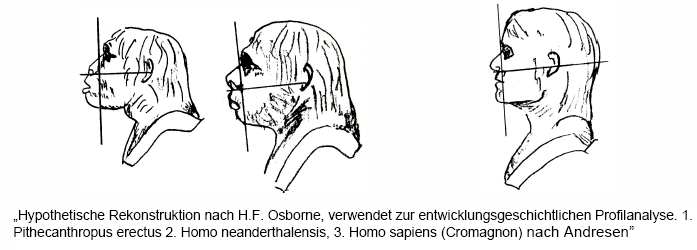Spee curve

The curve of Spee (also: curve of Spee , "sagittal Okklusionskurve" sagittal compensation curve ) is, the arc, the cutting edges and cusps of the upper teeth to one another and anterior (front) of the head of the mandible (joint head of the lower jaw) ( condyle tangent). The curve runs roughly in the form of a 1/8 circular arc along the teeth. The center of the imaginary circle lies in the front section of the orbit (eye socket), its radius is approximately 65 to 70 mm. It was named after the Kiel anatomist Ferdinand Graf von Spee (1855–1937).
The arched arrangement of the teeth through the Spee curve (compensation curve) in anatomically modern humans (Homo sapiens) is a space-saving mesiodistal arrangement. It causes a different profile and is associated with a different direction of pull of the masticatory muscles than in primate pines . The primate jaws and the jaws of fossil hominids are z. B. much longer.
Discrepancy in dentistry
The Speesche curve and the inclination of the joint path should be coordinated for a balanced occlusion . There is a discrepancy between orthodontists and other disciplines in dentistry . Orthodontists level the Speesche's curve, while other disciplines of dentistry tend to follow this curve.
Evolutionary aspects
The theory of evolution according to the specifications of the German Society for Orthodontics, DGKFO, 1963 and the official anatomy (Schumacher):


Functional importance
The principle of the curve of Spee is the chewing surfaces of the main force field of the chewing muscles located molars to get into a favorable position for the function. This is achieved when they are approximately at right angles to the main pulling direction of the masticatory muscles, so that the molar roots are mainly loaded longitudinally. Investigations in 1961 by G.-H. Schumacher showed that the temporalis , masseter and lateral pterygoid muscles do not act perpendicular to the constructed, artificial, straight occlusal plane, but rather at an angle.
The curvature of the Speeschen curve thus enables, according to G.-H. Schumacher that the masseter muscles can develop not only adduction but also protraction, retraction and lateral pull components. Straightening the chewing curve through orthodontic measures, for example, which produce a straight chewing plane, would destroy the entire chewing system of today's human, the functional balance and the profile design.
See also
Web links
Individual evidence
- ↑ Gert-Horst Schumacher : Functional anatomy of the orofacial system. Hüthig, Heidelberg 1985, ISBN 3-7785-1146-7 .
- ↑ G.-H. Schumacher 1997, DGKFO 1963
- ↑ Elie W. Amm, Die Spee'schekurve - Orthodontics and Reality , ZWP, February 12, 2010. Accessed January 24, 2017.
- ↑ a b G.-H. Schumacher 1997, The Evolution of Teeth

